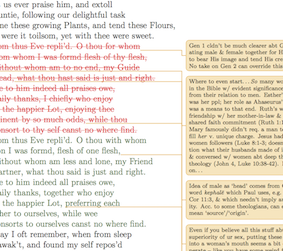His poetic mastery may have finally won me round to blank verse but Milton's notion of 'Paradise' was lost on me considerably before that first fateful forbidden bite. Then again, perhaps that's not surprising, as he seems convinced it was designed for Man (and no, I don't mean in the 'masculine generic' sense). As were women, naturally. A utopia of male entitlement and supremacy is no very entrancing abode for a woman who believes that she was made first and foremost for relationship with God, not for servitude to her husband. I reined in my desire to throw things – a lucky escape for my Kindle – and instead settled down to providing some constructive feedback. Maybe, with a bit of help (I'm sure he'd definitely thank me for it, *ahem*), he could salvage some of that lovely poetry after all...
Researching the above I stumbled on an illustrative, wryly amusing example of why Milton's poetic take on God's paradisal gender norms still matters 350 years on. The Genesis creation accounts didn't mention Eve's (nor Adam's) appearance, I noticed. Which got me wondering: is there anywhere in the Bible that explicitly affirms her alleged physical beauty? Or is it entirely a product of the ideals and assumptions that human readers (whether reasonably or otherwise) have brought to the text? Well, the top Google hit for my search – a Bible Gateway page – was enthusiastic to assert that indeed, Eve's "face, features and form were the loveliest women have ever had." Aha, I thought, readying myself for the chapter-and-verse citation I expected to accompany such a bold statement. But no. "While the Bible has no description of Eve’s physical appearance..." the article continued, before eventually ... wait for it ... quoting copiously from Milton.
It increasingly seems to me that many of our ideas about 'Biblical' gender identity and relationships (and about the Bible more generally) are products of similar circular reasoning. The Bible means 'X' because we all know it means 'X': our poets have written poems about it, our preachers have preached sermons on it, our churches and societies have been organised around it – for centuries! And any interpretation that disagrees or questions or suggests an alternative lays itself open to the charge, not just of heresy, but of cultural assimilation: adapting truth to 'fit the times'. Which strikes me as deeply ironic given the suspicious conformity of some of the most fiercely defended 'traditional' interpretations to the patriarchal cultural contexts within which they were developed.
Phyllis Trible urges the need to strip back the layers of centuries of patriarchally-informed Biblical exegesis and re-explore what the Bible actually says. Her 1973 essay 'Adam and Eve: Genesis 2-3 Re-Read' (cited in the comments above) was gratefully received by my Milton-troubled psyche. By sticking to the text, closely interrogating the original language used, and mistrusting the lenses through which it has typically been interpreted, she arrives at insights into humankind which are far more convincingly robust than the poet's, and also far more dignifying and hope-inspiring...
Researching the above I stumbled on an illustrative, wryly amusing example of why Milton's poetic take on God's paradisal gender norms still matters 350 years on. The Genesis creation accounts didn't mention Eve's (nor Adam's) appearance, I noticed. Which got me wondering: is there anywhere in the Bible that explicitly affirms her alleged physical beauty? Or is it entirely a product of the ideals and assumptions that human readers (whether reasonably or otherwise) have brought to the text? Well, the top Google hit for my search – a Bible Gateway page – was enthusiastic to assert that indeed, Eve's "face, features and form were the loveliest women have ever had." Aha, I thought, readying myself for the chapter-and-verse citation I expected to accompany such a bold statement. But no. "While the Bible has no description of Eve’s physical appearance..." the article continued, before eventually ... wait for it ... quoting copiously from Milton.
It increasingly seems to me that many of our ideas about 'Biblical' gender identity and relationships (and about the Bible more generally) are products of similar circular reasoning. The Bible means 'X' because we all know it means 'X': our poets have written poems about it, our preachers have preached sermons on it, our churches and societies have been organised around it – for centuries! And any interpretation that disagrees or questions or suggests an alternative lays itself open to the charge, not just of heresy, but of cultural assimilation: adapting truth to 'fit the times'. Which strikes me as deeply ironic given the suspicious conformity of some of the most fiercely defended 'traditional' interpretations to the patriarchal cultural contexts within which they were developed.
Phyllis Trible urges the need to strip back the layers of centuries of patriarchally-informed Biblical exegesis and re-explore what the Bible actually says. Her 1973 essay 'Adam and Eve: Genesis 2-3 Re-Read' (cited in the comments above) was gratefully received by my Milton-troubled psyche. By sticking to the text, closely interrogating the original language used, and mistrusting the lenses through which it has typically been interpreted, she arrives at insights into humankind which are far more convincingly robust than the poet's, and also far more dignifying and hope-inspiring...
Rather than legitimating the patriarchal culture from which it comes, the myth places that culture under judgment. And thus it functions to liberate, not to enslave. This function we can recover and appropriate. The Yahwist narrative tells us who we are (creatures of equality and mutuality); it tells us who we have become (creatures of oppression); and so it opens possibilities for change, for a return to our true liberation under God. In other words, the story calls female and male to repent. (Phyllis Trible, Adam and Eve: Genesis 2-3 Re-Read, 1973)

Comments